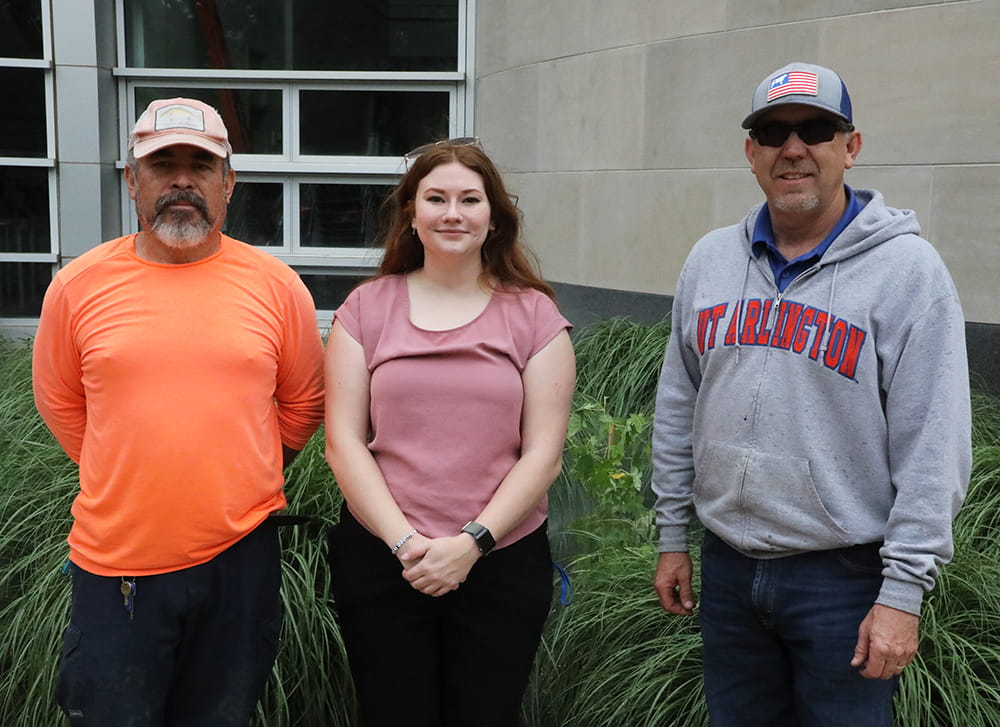Life Sciences Building, Room 206
501 S. Nedderman Drive
Box 19047
Arlington, TX 76019
UTA receives Moon Tree from NASA's Artemis I lunar mission

A “Moon Tree” grown from a seed which orbited the Moon aboard a NASA spacecraft is putting down roots at The University of Texas at Arlington.
The sweetgum seedling arrived at UTA on April 24 and was planted the next day outside the Chemistry & Physics Building, near the Planetarium.
The seedling is among those being given to universities, museums, science centers, federal agencies, and K-12 serving organizations through the NASA Office of STEM Engagement (OSTEM) as part of a national STEM engagement and conservation education initiative. OSTEM partnered with the U.S. Department of Agriculture (USDA) to fly five species of tree seeds aboard the Orion spacecraft as part of the Artemis I mission.
Artemis I was an uncrewed lunar orbit mission which launched on November 16, 2022, and marked NASA’s return to lunar exploration after a five-decade hiatus. Artemis I, which marked the first integrated flight test of the Orion spacecraft and Space Launch System rocket, logged more than 270,000 miles and returned to Earth on December 11, 2022, when it splashed down in the Pacific Ocean.
The tree seeds on board — almost 2,000 in all including sycamores, sweetgums, Douglas firs, loblolly pines, and giant sequoias — were taken to eight USDA Forest Service facilities, where they were grown into seedlings over the following year.
After reviewing hundreds of applications, NASA selected organizations from across the country to receive the Moon Tree seedlings. The UTA Planetarium is among those chosen for the first phase of distribution this spring. Subsequent planting cycles will occur in Fall 2024, Spring 2025, and Fall 2025.

McKenna Dowd, program coordinator for the UTA Planetarium, spearheaded UTA’s efforts to bring a Moon Tree to campus. She first learned of the program in April 2023 via a NASA educator newsletter and began pre-planning logistics with UTA and College of Science staff. The UTA President’s Office endorsed the idea, and when the application period opened in August 2023, Dowd was ready.
“I finally heard on April 8 — the day of the eclipse! — that we would be receiving a seedling,” Dowd said. “I knew that this seedling would be a perfect fit for this campus since UTA strives to inspire solutions with global impact and collaborative learning.”
Dowd said that the significance of having a living artifact of an Artemis Moon Tree will only further enhance the values of UTA and the surrounding community.
“This Moon Tree may inspire generations of students from around the world, or many of the K-12 students and surrounding public that visit our campus,” she said. “The tree will be a living reminder why we all must unite to preserve Earth for future generations. I even feel the impact of this tree will further foster the importance of students’ research, no matter what discipline.”
UTA’s Moon Tree seedling was grown at the USDA Forest Service Charles E. Bessey Nursery in Halsey, Nebraska, during the 2023 growing season.
The Artemis I Moon Tree program is based on a similar initiative which took place more than 50 years ago during the Apollo 14 lunar mission. Apollo 14 was the eighth crewed mission in the U.S. Apollo program and the third to land on the Moon, in early 1971. Command module pilot and former USDA Forest Service wildland firefighter Stuart Roosa brought hundreds of tree seeds, packed in small containers, aboard the spacecraft and into lunar orbit.
The Apollo seeds were grown into seedlings by the USDA Forest Service and were eventually given to national monuments and dignitaries around the world. Many were planted in 1976 as part of U.S. bicentennial celebrations. A number of these Apollo Moon Trees are still alive today.
The Planetarium plans to install a plaque by the Moon Tree describing its significance and to host a welcome ceremony for the seedling.
“Bringing a living Artemis mission legacy to campus will allow the many diverse people who visit, or even live, on our campus to hopefully be inspired by its message,” Dowd said. “Not to mention all of the incredible opportunities it can open up for students on campus to study and conduct research with the tree!”
The sweetgum tree (Liquidambar styraciflua) is native to the southeastern U.S., including parts of Texas. The tree tends to do well in Texas’ hot summer climate.
NASA chose institutions based on criteria that evaluated their suitability to care for the various tree species and their ability to maximize educational opportunities around the life and growth of the tree in their communities, according to a NASA news release.
“A new era of Moon trees will one day stand tall in communities across America,” NASA Administrator Bill Nelson said. “NASA is bringing the spirit of exploration back down to Earth because space belongs to everyone. The Artemis Generation will carry forth these seedlings that will be fertile ground for creativity, inspiration, and discovery for years to come.”
--
The UTA College of Science, a Carnegie R1 research institution, is preparing the next generation of leaders in science through innovative education and hands-on research and offers programs in Biology, Chemistry & Biochemistry, Data Science, Earth & Environmental Sciences, Health Professions, Mathematics, Physics and Psychology. To support educational and research efforts visit the giving page, or if you're a prospective student interested in beginning your #MaverickScience journey visit our future students page.